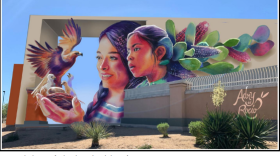WHAT’S GOING ON? This past weekend, Clark County required artist Cory McMahon to disassemble his exhibit, Space Available, from the Rotunda gallery of the Government Center in Downtown. It cited McMahon’s use of “discarded materials,” which the county’s call for proposals clearly prohibits. Canceling the show was an aesthetic decision, according to county spokesman Erik Pappa: “The Government Center is an architectural gem. The Rotunda Gallery is a very nice and inviting public space. Mr. McMahon’s work did not meet our standards.”
CAN YOU DESCRIBE THE EXHIBIT? Visually, it consists — consisted — of seven stacks of seemingly random objects placed around the rotunda. One was a pile of wood, another a stack of metal; there were boxes of McMahon’s possessions, some of his paintings, and so forth.
The concept? That McMahon was using this very public space to store his private belongings, the point being to complicate the seemingly clear distinctions between personal and public space. Thus the title Space Available — although what wasn’t available to viewers was a plaque that would have explained this conceit. Last Sunday, April 29, the county put a halt to the installation before McMahon could post it.
SO WHERE’S THE CONTROVERSY? It mostly resides in the phrase “discarded materials,” which sounds like junk the artist grabbed from a vacant lot on his way to install the show. But McMahon says the items in question — car parts, furniture, wood, metal scraps, generic stuff — are intrinsic to the conceptual art he makes and are things he actually owns. The artistic term for these is “readymades” (which McMahon used in his proposal), which typically indicates ordinary, usually manufactured items of no particular artistic merit or intent, which an artist repurposes for artistic reasons. This is often done to tweak the squares, challenge traditional notions of what should be in a gallery, and question who gets to make those distinctions. (In this case, at least, the answer is: the county.)
DIDN’T THE COUNTY KNOW WHAT IT WAS GETTING INTO? Yes, McMahon says; no, the county says. “I don’t think we knew how poorly thought out it was until we saw it all spread out across our Rotunda floor on Sunday,” Pappa says. However, McMahon’s accepted proposal does describe “free-standing structures made of wood, styrofoam, cardboard, and readymade objects such as folding tables, air mattresses, cases of bottled water, and packages of paper towel rolls. ... there will be paintings and drawings that lean against the structures and/or stand on their own.” If it doesn’t specify car parts and boxes of McMahon’s DVDs, the aesthetic of the installation still seems pretty clear.
In fact, what’s mainly missing from the proposal accepted by the county is McMahon’s witty wraparound concept of using the rotunda as his personal storage space — that evolved much later in the process. The proposal itself is basically a description of stuff. Which suggests the county accepted a proposal to stack objects in its lobby despite having little idea what the point was.
DID THE ARTIST AND COUNTY TRY TO WORK OUT A COMPROMISE? At the county’s request, McMahon says, he rearranged the exhibit — all the items were initially stacked together — and removed the auto parts, some furniture, boxes of possessions. But that wasn’t enough.
IS THE COUNTY PRACTICING CENSORSHIP? Some arts advocates have used that term on social media. But it doesn’t really describe this situation — after all, McMahon is free to make and display all the art he wants. Just not in this particular government-controlled space. (And it's worth noting that the county has long used this space as a rotating showcase for local artists rather than taking the easier route and simply installing some innocuous plop art and calling it a day.)
GOTTA ASK — IS THIS STUFF ART? Ah, the obvious question. Reactions were certainly mixed. One viewer, during the short time Space Available was up, told KNPR’s State of Nevada that it looked like recycling day. Another allowed that art is in the eye of the beholder. It’s high-concept, for sure, and requires a willingness to consider that the art resides in the idea represented by the objects rather than the craft with which they’re made.
But let’s vector in from a possibly more fertile angle here: Can it *be* art, and if so, how? “It’s hard to imagine any gallery of repute showing this,” Pappa emailed us last week. Not really. Work of similar aesthetic is hardly remarkable in the art world. Indeed, there’s a hundred-year history of artists using readymades to challenge bourgeois assumptions — most famously when Marcel Duchamp laid a urinal in a New York gallery in 1917 (imagine that in the Rotunda!) — and, in a traditional white-walled art space, Space Available would likely have made more immediate sense.
Presumably UNLV’s Barrick Museum qualifies as a gallery of repute, and, as noted by Ed Fuentes on his Paint This Desert blog, it’s currently showing a crushed shopping cart retrieved and arted up by artist Brent Holmes (a Desert Companion designer) — a piece that first appeared the county’s own Winchester Center Gallery. There have been plenty of displays of art made from found objects — many of them actually discarded — in Las Vegas.
Clearly, there was the potential for this to be art. Whether Space Available itself rose to that threshold is for each viewer to decide — or would have been. But consider this: By asking Is this art?, you are, to some extent, already venturing down one of the roads this exhibit wanted you to. That sounds a bit like a metric of success, whether the art is pretty or flatters the architecture.
(Listen to a story on this topic by KNPR's State of Nevada here.






